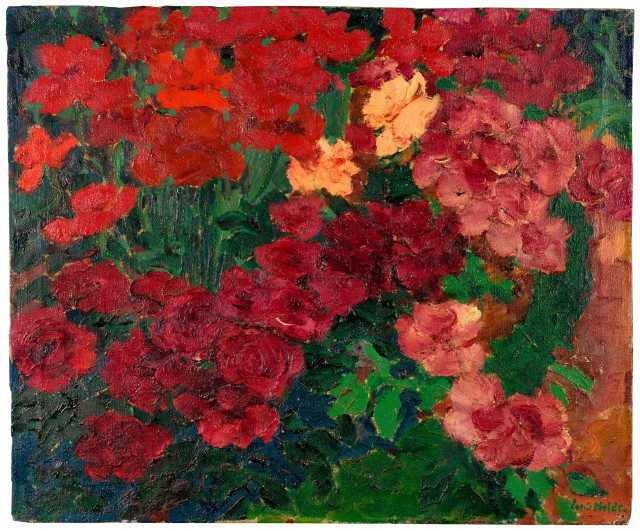- EN
Log in
- Live Auctions
- Past auctions
- More
- Gallery
- Art Dealing
- Publishing
- Kornfeld today
- The Story of Kornfeld
- Information




Nolde 1867 - 1956 Seebüll
1917
Oil on canvas
73,3x88,3 cm
Signed lower right by the artist in brush in green oil paint "Emil Nolde". Signed again on the reverse side of the chassis in a brush in black oil paint "Emil Nolde" and titled in his own hand "Mohn u. Rosen" (Poppy and Roses)
Martin Urban, Emil Nolde, Werkverzeichnis der Gemälde, Band II, 1915-1951, München 1987, no. 760, reprod.
Collection Otto Nathan Deutsch, Frankfurt am Main (before 1930 until 1939)
Collection Gertrud Eberle, Madrid
R. N. Ketterer, Campione d'Italia, Catalogue Modern Art III, 1966, cat. no. 141, reprod. full-page in colours
Collection Ernesto Blohm, Caracas; by inheritance to
Private collection Switzerland
Frankfurt 1918, Kunstsalon Ludwig Schames, Emil Nolde, cat. no. 14
Wiesbaden 1919, Nassauischer Kunstverein, Emil Nolde, nach Angabe im Werkverzeichnis cat. no. 181
Kiel 1920, Kunstverein, Rohlfs - Nolde - Barlach, cat. no. 46
Impeccable condition and perfectly fresh in colours, not varnished, on the old stretcher
Nolde's flower paintings are considered highlights in his oeuvre and often use their subject as a vehicle to express moods and emotions. The artist was fascinated by the fleeting beauty and elegance of flowers. He wrote in his 1934 essay "Years of Struggles": "The blooming colours of flowers and the purity of these colours, I loved them. I loved the flowers in their fate: sprouting, blossoming, shining, glowing, delighting, bowing, withering, ending discarded in the pits."
In 1916 Nolde moved to the small farmhouse of Utenwarf on the North Frisian-Danish west coast near Tønder and the river Vidå. The landscape and nature were his daily companions. In the summer of 1917 he painted a group of seven pictures of flowers and water lilies, all in almost the same format and intense colouring, clearly inspired by the floral splendour in Ada Nolde's flower garden. The painting offered here is considered to be one of the most beautiful of these works in terms of its composition and its rich colours
After an amicable settlement with the heirs of Otto Nathan Deutsch, represented by the New York law firm "Rowland & Petroff", the work is free of any claims
1917
Öl auf Leinwand
73,3x88,3 cm
Unten rechts vom Künstler in Pinsel in grüner Ölfarbe signiert "Emil Nolde". Rückseitig auf dem Chassis in Pinsel in schwarzer Ölfarbe nochmals signiert "Emil Nolde" und eigenhändig betitelt "Mohn u. Rosen"
Martin Urban, Emil Nolde, Werkverzeichnis der Gemälde, Band II, 1915-1951, München 1987,
Slg. Otto Nathan Deutsch, Frankfurt am Main (vor 1930 bis 1939)
Slg. Gertrud Eberle, Madrid
R. N. Ketterer, Campione d'Italia, Katalog Moderne Kunst III, 1966,
Slg. Ernesto Blohm, Caracas; durch Erbschaft an
Privatsammlung Schweiz
Frankfurt 1918, Kunstsalon Ludwig Schames, Emil Nolde,
Wiesbaden 1919, Nassauischer Kunstverein, Emil Nolde, nach Angabe im Werkverzeichnis
Kiel 1920, Kunstverein, Rohlfs - Nolde - Barlach,
Tadellos und vollkommen farbfrisch in der Erhaltung, nicht gefirnisst, auf dem alten Chassis
Noldes Blumenbilder gelten als Höhepunkte in dessen Œuvre und nutzen ihr Sujet oft als Vehikel, um expressiv Stimmungen und Emotionen auszudrücken. Der Künstler war fasziniert von der vergänglichen Schönheit und der Eleganz der Blüten. Er schrieb 1934 in seiner Schrift "Jahre der Kämpfe": "Die blühenden Farben der Blumen und die Reinheit dieser Farben, ich liebte sie. Ich liebte die Blumen in ihrem Schicksal: emporspriessend, blühend, leuchtend, glühend, beglückend, sich neigend, verwelkend, verworfen in der Gruben endend"
Im Jahr 1916 zog Nolde in das kleine Bauernhaus Utenwarf an der nordfriesisch-dänischen Westküste nahe Tondern und des Flusses Vidå. Die Landschaft und die Natur waren seine täglichen Begleiter. Im Sommer 1917 malte er eine Gruppe von sieben Blumen- und Seerosenbildern, alle im nahezu gleichen Format und in intensiver Farbgebung, klar inspiriert von der Blumenpracht in Ada Noldes Blumengarten. Das hier angebotene Gemälde gilt in der Komposition und seiner satten Farbigkeit als eines der schönsten dieser Werke überhaupt
Das Werk ist nach der gütlichen Einigung mit den Erben von Otto Nathan Deutsch, vertreten durch die New Yorker Kanzlei "Rowland & Petroff", frei von jeglichen Ansprüchen





